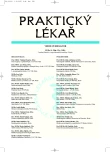Combination drug therapy for hypertension
Kombinační léčba hypertenze
Kombinace léků různých tříd antihypertenziv poskytuje aditivní antihypertenzivní účinek a tím minimalizuje pravděpodobnost vzniku nežádoucích účinků závislých na dávce antihypertenziva. Jelikož kontrola hypertenze v České republice i ve světě je nedobrá a cílových hodnot TK se dosahuje jen u 5–30 % pacientů, je třeba rozšířit používání kombinační léčby. Monoterapie je schopná dosáhnout cílových hodnot TK pouze u 10–25 % pacientů. Setrvávání na monoterapii při nedosažení cílových hodnot TK ohrožuje pacienta vznikem cerebrovaskulárních i kardiovaskulárních komplikací. Kombinační léčba je indikována u těchto skupin hypertoniků:
a) u všech hypertoniků, u nichž systolický TK přesahuje cílové hodnoty systolického TK o >20 mmHg nebo diastolický TK přesahuje cílové hodnoty diastolického TK o >10 mmHg;
b) u nemocných s diabetes mellitus (protože cílové hodnoty jsou 130/80 mm Hg);
c) u nemocných s poškozením cílových orgánů;
d) u nemocných s ledvinným nebo kardiovaskulárním onemocněním (pacienti s ICHS, pacienti po cévní mozkové příhodě).
Fixní kombinace mají výhodu v tom, že snižují počet tablet užívaných nemocnými; ale jejich hlavní výhodou je skutečnost, že obsahují často nižší dávky jednotlivých antihypertenziv. Dosud oblíbená dvojkombinace thiazidové diuretikum a betablokátor není vhodná u pacientů s metabolickým syndromem a u pacientů se sklonem k diabetu, protože zhoršuje glycidový metabolismus. Nevhodné jsou také kombinace používající dávky thiazidových diuretik vyšší než 25 mg, optimální jsou dávky 12,5 mg hydrochlorothiazidu. Vyloučené jsou kombinace 2 antihypertenziv téže třídy antihypertenziv. Velmi účinná se jeví také kombinace antihypertenzní a hypolipidemické léčby. Práce uvádí přehled vhodných dvojkombinací, trojkombinací i čtyřkominací antihypertenziv. Přináší také přehled fixních kombinací antihypertenziv na našem trhu.
Klíčová slova:
kombinační léčba hypertenze, fixní kombinace, indikace kombinační léčby.
Authors:
sr. J. Widimský
Authors‘ workplace:
Přednosta: prof. MUDr. Vladimír Staněk, CSc.
; Přednosta: prof. MUDr. Josef Kautzner, CSc.
; Subkatedra kardiologie IPVZ, Praha
; Klinika kardiologie, IKEM Praha
Published in:
Prakt. Lék. 2007; 87(9): 525-529
Category:
Various Specialization
Overview
A combination of various sorts of antihypertensive drugs offers an additive blood pressure lowering effect and reduces the risk of side effects that are dependent on antihypertensive drug dose. Since hypertension control in the Czech Republic and worldwide is not satisfactory, and a target BP is attained in only 5–30 % of patients, it is necessary to extend the use of combined hypertension treatment. Monotherapy can only help attain a target BP in 10–25 % of patients. Compliance with monotherapy without reaching the target BP puts patients at risk of cerebrovascular and cardiovascular complications. Combined treatment is indicated in:
a) all hypertonic patients with a systolic BP that is >0.20 mmHg above target level or diastolic BP that is >10 mmHg higher than the target level,
b) patients with diabetes mellitus (target levels are 130/80 mm Hg,
c) patients with critical organ impairment;
d) patients with renal or cardiovascular disease (patients with IHD, patients after a cerebrovascular event).
Fixed combinations are more comfortable for patients (requiring them to take fewer pills); however their main advantage is that they often reduce the dose of individual anti-hypertensive drugs. The hitherto favourite double combination of a thiazide diuretic and a beta blocker is not suitable for patients with metabolic syndrome and in patients at risk of diabetes, because it impairs glucose metabolism. Combinations containing doses of thiazide diuretic higher than 25 mg are also unsuitable, the optimal dose of hydrochlorothiazide is 12.5mg. Combinations of 2 antihypertensives of the same sort are inappropriate. A combination of antihypertensive and a hypolipidemic treatment is also very effective. The article offers a survey of suitable double, triple and quadruple combinations of antihypertensive drugs, and reviews fixed combinations of hypertensive drugs available on the Czech market.
Key words:
combined treatment of hypertension, fixed combination, indications of combined treatment
Labels
General practitioner for children and adolescents General practitioner for adultsArticle was published in
General Practitioner

2007 Issue 9
- Metamizole vs. Tramadol in Postoperative Analgesia
- Memantine in Dementia Therapy – Current Findings and Possible Future Applications
- What Effect Can Be Expected from Limosilactobacillus reuteri in Mucositis and Peri-Implantitis?
- Hope Awakens with Early Diagnosis of Parkinson's Disease Based on Skin Odor
- Metamizole in perioperative treatment in children under 14 years – results of a questionnaire survey from practice
Most read in this issue
- Hypotermia as an injury, illness, symptom
- Induratio penis plastica – diagnostics and treatment
- Calcium score assessment combined with myocardial perfusion stress test by single photon tomography (SPECT). Two case studies.
- Hantaviruses and related diseases in the Czech Republic
